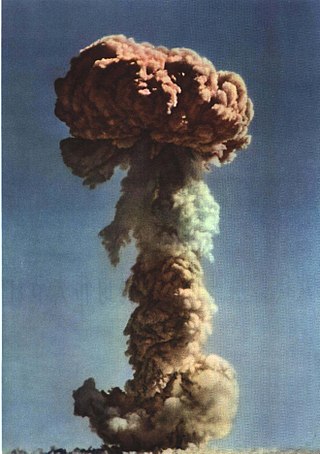Related Research Articles

The Tsar Bomba, also known by the alphanumerical designation "AN602", was a thermonuclear aerial bomb, and the most powerful nuclear weapon ever created and tested. The Soviet physicist Andrei Sakharov oversaw the project at Arzamas-16, while the main work of design was by Sakharov, Viktor Adamsky, Yuri Babayev, Yuri Smirnov, and Yuri Trutnev. The project was ordered by Nikita Khrushchev in July 1961 as part of the Soviet resumption of nuclear testing after the Test Ban Moratorium, with the detonation timed to coincide with the 22nd Congress of the Communist Party of the Soviet Union.

Igor Vasilyevich Kurchatov, was a Soviet physicist who played a central role in organizing and directing the former Soviet program of nuclear weapons.

Nuclear weapons tests are experiments carried out to determine the performance, yield, and effects of nuclear weapons. Testing nuclear weapons offers practical information about how the weapons function, how detonations are affected by different conditions, and how personnel, structures, and equipment are affected when subjected to nuclear explosions. However, nuclear testing has often been used as an indicator of scientific and military strength. Many tests have been overtly political in their intention; most nuclear weapons states publicly declared their nuclear status through a nuclear test.

The nuclear arms race was an arms race competition for supremacy in nuclear warfare between the United States, the Soviet Union, and their respective allies during the Cold War. During this same period, in addition to the American and Soviet nuclear stockpiles, other countries developed nuclear weapons, though none engaged in warhead production on nearly the same scale as the two superpowers.

The RDS-1, also known as Izdeliye 501 and First Lightning, was the nuclear bomb used in the Soviet Union's first nuclear weapon test. The United States assigned it the code-name Joe-1, in reference to Joseph Stalin. It was detonated on 29 August 1949 at 7:00 a.m., at the Semipalatinsk Test Site, Kazakh SSR, after top-secret research and development as part of the Soviet atomic bomb project.

The Soviet atomic bomb project was the classified research and development program that was authorized by Joseph Stalin in the Soviet Union to develop nuclear weapons during and after World War II.
Joe 4 was an American nickname for the first Soviet test of a thermonuclear weapon on August 12, 1953, that detonated with a force equivalent to 400 kilotons of TNT. The proper Soviet terminology for the warhead was RDS-6s, Reaktivnyi Dvigatel Specialnyi, lit. 'Special Jet Engine'.
RDS-37 was the Soviet Union's first two-stage hydrogen bomb, first tested on 22 November 1955. The weapon had a nominal yield of approximately 3 megatons. It was scaled down to 1.6 megatons for the live test.

Project 596 was the first nuclear weapons test conducted by the People's Republic of China, detonated on 16 October 1964, at the Lop Nur test site. It was a uranium-235 implosion fission device made from weapons-grade uranium (U-235) enriched in a gaseous diffusion plant in Lanzhou.
RDS-4 was a Soviet nuclear bomb that was first tested at Semipalatinsk Test Site, on August 23, 1953. The device weighed approximately 1,200 kilograms (2,646 lb). The device was approximately one-third the size of the RDS-3. The bomb was dropped from an IL-28 aircraft at an altitude of 11 kilometres (7 mi) and exploded at 600 metres (1,969 ft), with a yield of 28 kt.
Yevgeny Ivanovich Zababakhin was a Soviet military engineer, theoretical physicist and one of the chief designers of nuclear weapons in the USSR. Amongst many others, he was involved in the first Soviet nuclear bomb (RDS-1) and the design of the first Soviet two-stage hydrogen bomb (RDS-37).

Yuri Alexeyevich Trutnev was a Russian physicist and a professor of engineering at the National Research Nuclear University MEPhI.
The RDS-2 was the second atomic bomb developed by the Soviet Union as an improved version of the RDS-1. It included new explosive lenses along with a new core design to decrease the probability of pre-detonation or 'fizzle'. The RDS-2 weighed approximately 3,200 kilograms (7,055 lb) and had a diameter of 1.25 m. The RDS-2 was tested on September 24, 1951 and produced a 38.3 kiloton yield. It was detonated from the top of a tower thirty meters high. The detonation was controlled by a bomber flying over the testing site instead of the detonation being controlled by a ground control center.
The RDS-2 nuclear warhead was created and designed by the Soviet Union during the late 1940s and early 1950s. RDS-2 was first secretly tested on September 24, 1951, at a Soviet test site in Kazakhstan. RDS-2 was a plutonium only device with an estimated yield of 38 kt.

The All-Russian Scientific Research Institute of Experimental Physics (VNIIEF) is a research institute based in Sarov, Russia and established in 1947. During the Soviet era, it was known as KB-11 and All-Soviet (All-Union) Scientific Research Institute of Experimental Physics. It is currently part of the Rosatom group.
The RDS-5 was a plutonium based Soviet atomic bomb, probably using a hollow core. Two versions were made. The first version used 2 kg Pu-239 and was expected to yield 9.2 kilotons. The second version used only 0.8 kg Pu-239
Vyacheslav Petrovich Feodoritov (February 28, 1928 - January 2, 2004), k.N, was a Russian physicist in the former Soviet program of nuclear weapons. He was a co-designer of the first two-stage Soviet thermonuclear device, the RDS-37, and became a chief of laboratory at Arzamas-16, now known as the All-Russian Scientific Research Institute of Experimental Physics.
Viktor Borisovich Adamskyk.N was a Russian physicist of Ukrainian origin known for his work on the former Soviet program of nuclear weapons.
References
- 1 2 Bukharin, Oleg; Kadyshev, Timur; Miasnikov, Eugene; Sutyagin, Igor; Tarasenko, Maxim; Zhelezov, Boris (2001). Podvig, Pavel (ed.). "Soviet Strategic Nuclear Forces". Cambridge, Massachusetts: The MIT Press.
{{cite journal}}: Cite journal requires|journal=(help) - ↑ "RDS-3 Soviet atomic bomb test (1951)". YouTube. 2022.